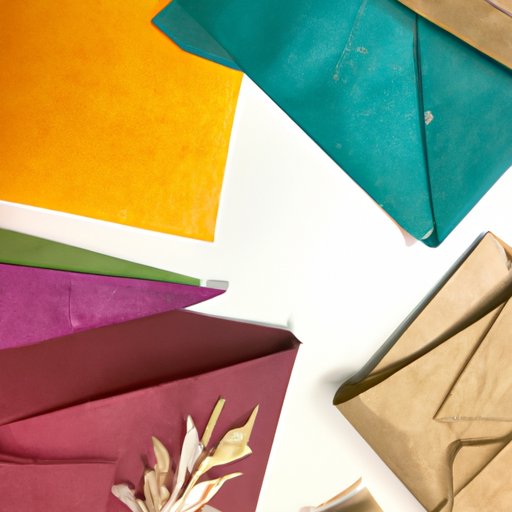I. Introduction
Have you ever found yourself in need of an envelope, only to discover that you don’t have any that are the right size or style? Or perhaps you’re tired of buying expensive pre-made envelopes and want a more cost-effective solution. Making your own envelopes can be a creative and satisfying solution to these common problems. In this article, we will cover everything you need to know about making envelopes from scratch, personalizing them with decorative papers, using templates, creating envelope liners, and even upcycling old paper materials into unique and creative envelopes.
II. Making Envelopes from Scratch
The first step in making your own envelopes is choosing the right paper. You can use a variety of different papers, from plain printer paper to decorative handmade paper. Once you’ve chosen the paper you want to use, follow these steps:
- Start with a rectangular piece of paper.
- Fold the bottom edge up to meet the top edge, creasing the paper in the middle.
- Open the paper back up and fold the two side edges in to meet the center crease.
- Make a small fold at the bottom of the paper to create a triangular flap.
- Fold the flap up over the sides of the envelope and secure it with glue.
- Allow the glue to dry before using the envelope.
Once you’ve created the basic envelope shape, you can customize it with decorations or labels. Try using colorful washi tape, stickers, or even paint to add a creative touch to your envelopes.
III. Personalizing Envelopes with Decorative Papers
If you want to take your envelope-making skills to the next level, try adding decorative papers to your envelopes. You can use a variety of different papers, including patterned scrapbook paper, handmade paper, or even wrapping paper. Here’s how:
- Start by creating a basic envelope using plain paper.
- Cut your decorative paper so that it is slightly smaller than the plain paper envelope.
- Using glue or double-sided tape, attach the decorative paper to the front of the plain paper envelope.
- Allow the adhesive to dry before using the envelope.
To create a cohesive set of personalized envelopes, try using the same decorative paper on all of them. This will create a coordinated look that is both beautiful and functional.
IV. DIY Envelope Templates
Creating your own envelope templates can be a fun and easy way to make custom envelopes in a variety of different sizes and styles. Here’s how to get started:
- Choose the size and style of envelope you want to create.
- Draw a template on a piece of paper, using a ruler to ensure straight lines.
- Cut out the template using scissors or a craft knife.
- Use the template to trace the envelope shape onto your chosen paper.
- Cut out the envelope shape and fold it following the steps outlined in section II.
If you’re not comfortable creating your own envelope templates, there are plenty of resources available online. Try searching for “free envelope templates” to find a variety of different designs that you can download and print.
V. Making Envelope Liners
Envelope liners are a great way to add a touch of elegance and sophistication to your envelopes. They can also help to protect the contents of your envelope from damage. Follow these steps to create your own envelope liners:
- Measure the inside of your envelope to determine the size of the liner you need.
- Using a ruler and a pencil, draw the liner shape onto your chosen paper.
- Cut out the liner shape using scissors or a craft knife.
- Insert the liner into your envelope and secure it with glue or double-sided tape.
When choosing paper for your envelope liners, consider using a lightweight decorative paper that complements the design of your envelope. You can even use leftover scraps of decorative paper to create unique and interesting liners.
VI. Upcycling Old Paper Materials into Envelopes
If you’re a fan of upcycling and repurposing, making envelopes from old paper materials is a great way to create unique and eco-friendly envelopes. Here are some materials you can use:
- Old maps or atlas pages
- Sheet music
- Magazine or catalog pages
- Wrapping paper
- Wallpaper samples
To turn these materials into envelopes, follow the basic steps outlined in section II, but use the recycled material instead of plain paper. You can even mix and match materials to create one-of-a-kind envelopes that are sure to stand out.
VII. Conclusion
By making your own envelopes, you’ll never have to settle for a boring or ill-fitting envelope again. Whether you choose to make envelopes from scratch, add decorative paper, use templates, create envelope liners, or upcycle old paper materials, the possibilities are endless. So why not give it a try?
For more envelope-making ideas and inspiration, check out craft blogs, social media accounts, and online tutorials. With a little creativity and a few basic supplies, you’ll be making beautiful and functional envelopes in no time.
